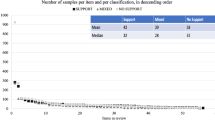Abstract
Previous research has shown that experimenter-presented masculine generics can create male bias in the gender content of subjects' imagery. The present study tests experimentally whether subjects' own use of masculine generics has a similar effect on their imagery. College student subjects were induced to complete sentence fragments using masculine or unbiased generics, then asked to describe their imagery for each sentence and to give a first name to fit the person they visualized for each sentence. These dependent measures were coded for gender, and as predicted, analysis of variance showed that male bias was higher in the masculine generic condition than in the unbiased condition. Also as predicted, male subjects were more male-biased overall than were female subjects. The findings are discussed in terms of linguistic relativity (the proposition that language can shape thought), prototypicality (the most typical he is probably a man), and activation of multiple meanings (he has male-specific and gender-neutral denotations, and both may be activated even when the gender-neutral meaning is intended).
Similar content being viewed by others
References
Bem, S. L., & Bem, D. J. Does sex-biased job advertising “aid and abet” sex discrimination? Journal of Applied Social Psychology, 1973, 3(1), 6–18.
Berlin, B., & Kay, P. Basic color terms: Their universality and evolution. Berkeley: University of California Press, 1969.
Broverman, I. K., Vogel, S. R., Broverman, D. W., Clarkson, F. E., Clarkson, F. E., & Rosenkrantz, P. S. Sex-role stereotypes: A current appraisal. Journal of Social Issues, 1972, 28, 59–78.
Brown, R. Social psychology (2nd ed.). New York: The Free Press, 1986.
Conrad, C. Context effects in sentence comprehension: A study of the subjective lexicon. Memory and Cognition, 1974, 2, 130–138.
Cookston, J. Is English sexist? UCLA Daily Bruin, January 22, 1988, pp. 12, 14–15.
Dell, G. S., McKoon, G., & Ratcliff, R. The activation of antecedent information during the processing of anaphoric reference in reading. Journal of Verbal Learning and Verbal Behavior, 1983, 22, 121–132.
Fishman, J. A. The systematization of the Whorfian hypothesis. Behavioral Science, 1960, 5, 323–379.
Fishman, J. A. Whorfianism of the third kind: Ethnolinguistic diversity as a worldwide societal asset. Language in Society, 1982, 2, 1–14.
Hamilton, M. C. A man is a person, a woman is a woman: Evidence for the “people = male” bias. Paper presented at a meeting of the National Women's Studies Association, Minneapolis, MN, June 1988.
Hamilton, M. C., & Henley, N. M. Detrimental consequences of generic masculine usage. Paper presented at the meeting of the Western Psychological Association, Sacramento, CA, April 1982.
Hamilton, M. C., & Hunter, B. Jury instructions worded in the masculine generic: Can a woman claim self-defense when “he” is threatened? Paper presented at a meeting of the Association for Women in Psychology, Bethesda, MD, March 1988.
Harrison, L., & Passero, R. Sexism in the language of elementary textbooks. Science and Children, 1975, 12(4), 22–25.
Heilman, M. Miss, Mrs., Ms., or none of the above. American Psychologist, 1975, 30(4), 516–518.
Henley, N. M., Gruber, B., & Lerner, L. Effects of sex-biased language on attitudes and self-esteem. Paper presented at a meeting of the Southern California Language and Gender Interest Group, Los Angeles, CA, October 1984.
Lucy, J. A., & Schweder, R. A. Whorf and his critics: Linguistic and non-linguistic influences on color memory. American Anthropologist, 1979, 81(3), 581–615.
MacKay, D. G. Psychology, prescriptive grammar and the pronoun problem. American Psychologist 1980, 35, 444–449.
Martyna, W. Using and understanding the generic masculine: A social psychological approach to language and the sexes. Dissertation Abstracts International, 1978, 39, 3050B.
McCarthy, W. J., Hamilton, M. C., Leaper, C., Pader, E., Rushbrook, S., & Henley, N. M. Social influences on what to call her: “Woman,” “girl,” or “lady.” In L. DeVillers (Chair). Advances in language and gender research. Symposium conducted at the meeting of the American Psychological Association, Los Angeles, CA, August 1985.
O'Sullivan, C. S., Cole, C. A., & Moseley, S. Content and structure of gender stereotypes. Paper presented at the meeting of the Southwestern Psychological Association, Dallas, TX, April, 1982.
Rosch, E. Linguistic relativity. In A. Silverstein (Ed.), Human communication: Theoretical explanations. Hillsdale, NJ: Lawrence Erlbaum, 1974.
Rosch, E. Cognitive representations of semantic categories. Journal of Experimental Social Psychology: General, 1975, 104, 192–223.
Sapir, E. The status of linguistics as a science. Language, 1929, 5, 207–214.
Silveira, J. Generic masculine words and thinking. In C. Kramarae (Ed.), The voices and words of women and men. Oxford: Pergamon Press, 1980.
Warren, R. E., & Warren, N. E. Dual semantic encoding of homographs and homophones embedded in context. Memory and Cognition, 1976, 4, 582–592.
Whorf, B. L. Language, thought, and reality: Selected writings of Benjamin Lee Whorf (J. B. Carroll, Ed.). Cambridge: MIT Press, 1956.
Author information
Authors and Affiliations
Additional information
I would like to thank Anne Peplau, William McCarthy, Elizabeth Bjork, Jack DuBois, Pamela Munro, and especially Nancy Henley for thier help during many phases of this research. Thanks also to Christie Chambers for her assistance in data collection. This article is based on Chapter Two of the author's dissertation, submitted in partial satisfaction of Ph.D. requirements at the University of California, Los Angeles.
Rights and permissions
About this article
Cite this article
Hamilton, M.C. Using masculine generics: Does generic he increase male bias in the user's imagery?. Sex Roles 19, 785–799 (1988). https://doi.org/10.1007/BF00288993
Issue Date:
DOI: https://doi.org/10.1007/BF00288993




